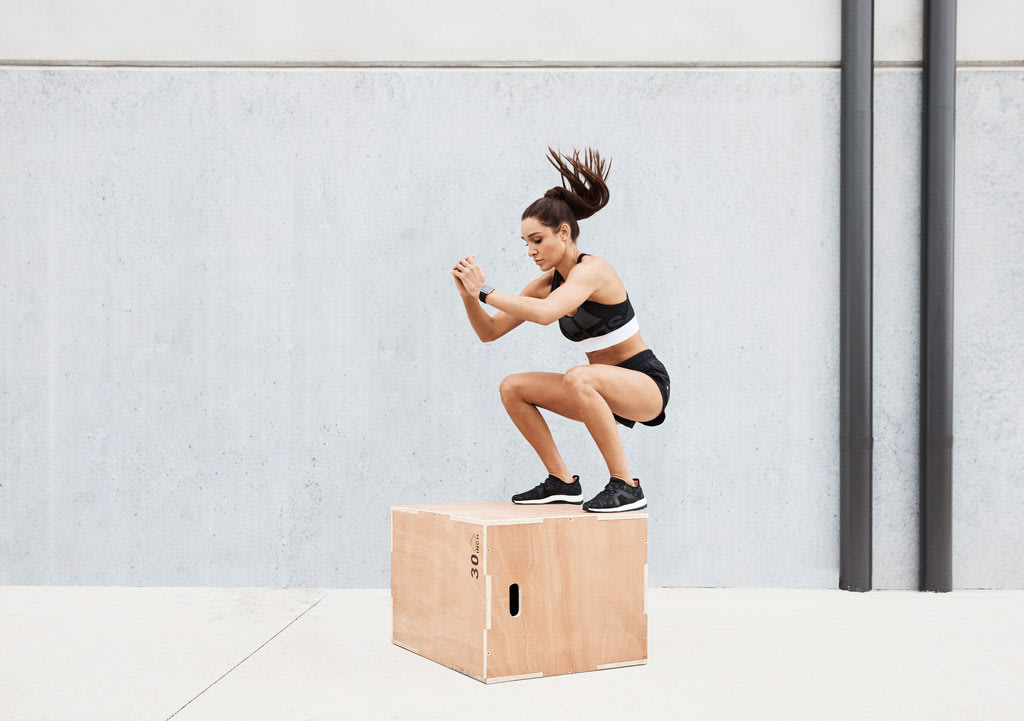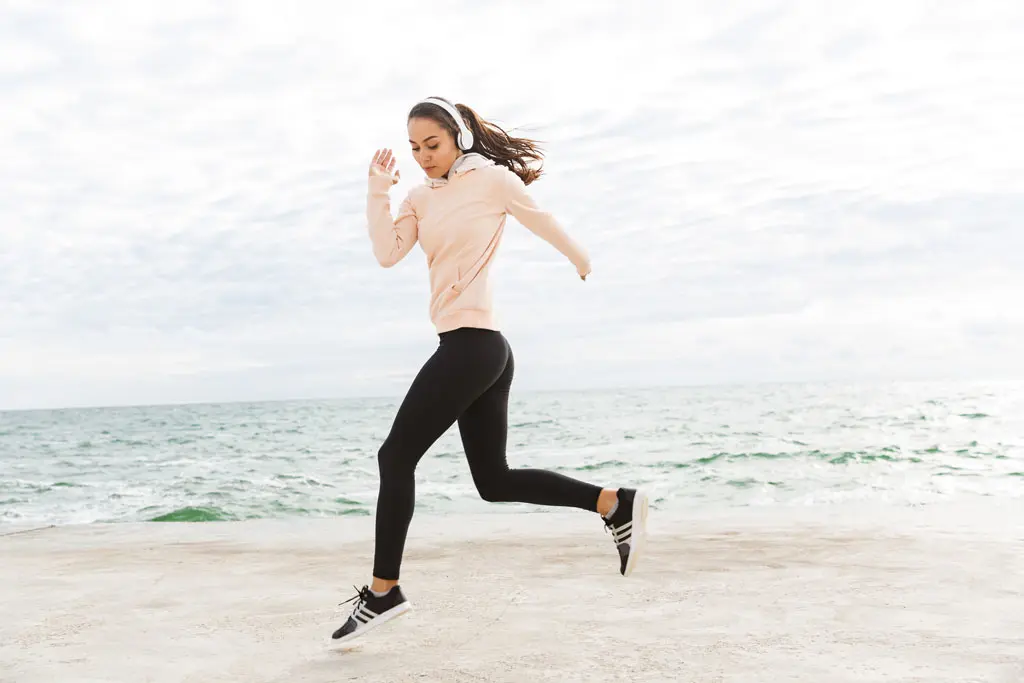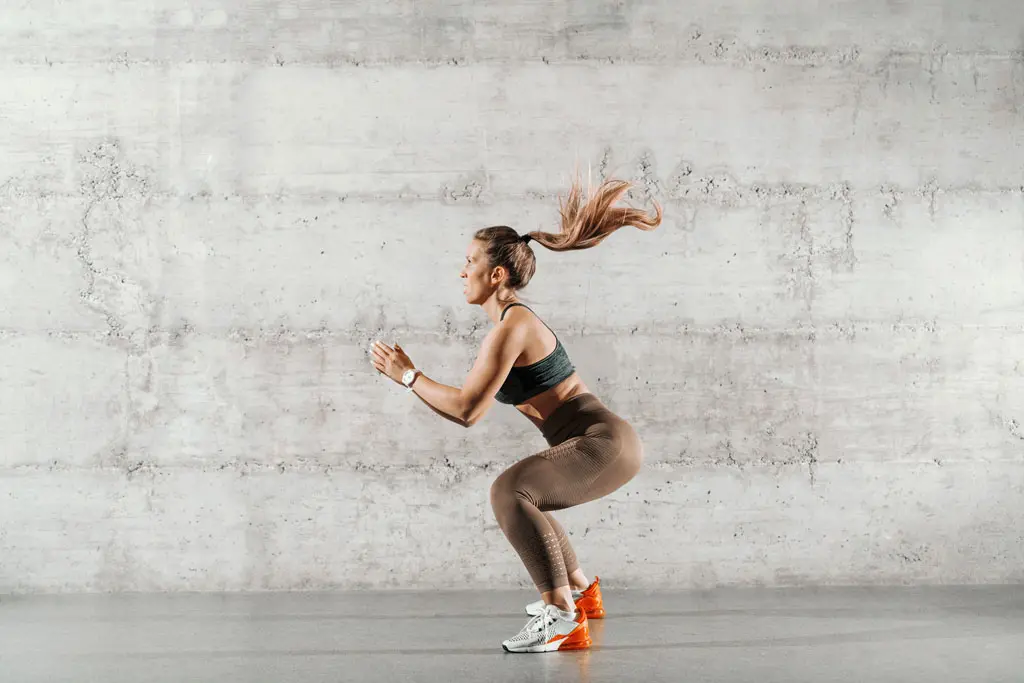Plyometrics Exercises: What Are They & What Are The Benefits?

May 9, 2021

Plyometrics exercises, aka jump or plyo training, are a highly effective way to build your strength, speed, cardio fitness, coordination, explosive power and agility. They really do tick so many boxes when it comes to improving every component of your fitness!
Plyometric movements play a big part in Head Trainer Kayla Itsines’ programs on the Sweat app, such as her signature High Intensity program.
She (and many women in the Sweat Community) love incorporating plyometrics into their training because it’s so efficient — just a short plyo workout can give you an intense cardio workout and while strengthening your muscles!
Here’s a run-down of what plyometric training involves, the benefits, who this training style is not so suitable for, and everything you need to get started.
What is plyometrics?
Plyometrics or “plyo” training essentially refers to jumping exercises - think jump squats, jump lunges, tuck jumps and burpees. It’s all about power, speed and coordination (plus a bit of air-time!).
Each plyometric exercise has three phases:
The eccentric phase where you prepare or load your body for the movement, such as sinking into a squat ready to jump into the air.
The amortisation phase, where your body begins to move upwards and gain momentum for the explosive jump. You want to make this phase short to build speed and power! If you spend too long in this phase, you reduce your power and energy for the jump itself.
The concentric phase, where you actually leave the ground and get air-time!
During plyometrics exercises, your muscles are stretched, have a brief rest and then contract rapidly on impact with the ground. This is often referred to as the stretch-shortening cycle.
We typically think of plyometrics exercises as lower-body movements, but there are also upper-body exercises such as plyometric push-ups, wall-balls and medicine ball slams which all share those same three phases of movement.
However, some of these exercises can be hard on the body. If you have an injury or are new to exercise, other forms of exercise may be more appropriate and we suggest you ask your health professional for their advice. Once you’ve established a base level of fitness and have been cleared to do jumping exercises, you can add in plyometrics.

Benefits of plyometric training
Jumping exercises are popular for a reason. Here are some of the top benefits you might experience when your workouts take you sky-high!
Improve power: Power is a combination of strength and speed. Plyometric exercises help increase the speed with which fast-twitch muscle fibres contract, recruiting more muscle fibres than stand-alone strength exercises. This can also help to build your muscle power for strength training workouts and cardio sessions!
Better coordination and agility: The ability to control your body and change direction quickly depends on the fast recruitment of muscle fibres. This is important for many team sports, training styles and everyday movements. Plyometric exercises can improve overall athletic performance and reduce the risk of injury during exercise.
Improve speed: Plyometric exercises recruit the fast-twitch muscle fibres in your muscles, improving the speed of muscle response.
Improve balance: Jumping exercises challenge your balance with every leap and landing, which can help strengthen the stabilising muscles, ligaments and tendons around the joints.
Boost cardio fitness: Plyometric exercises challenge your muscles and increase your heart rate which can boost your fitness for other activities.
Better neuromuscular control: The nervous system carries communication from your brain to the muscles, and plyometric exercises can help increase the speed and strength of these signals. Think of this like the mind-body connection!
High energy output: Since plyo workouts are high-intensity, they require a lot of energy in a short space of time. Hello, big endorphin rush!
Support bone health: If you’re comfortable performing jumping movements and have no joint issues, including some jumping movements in your routine can help to build bone strength.
No equipment required: Plyometric training can be done anywhere, using minimal equipment! This makes them perfect for at-home workouts.
Great option for short workouts: Because plyometrics exercises are high-intensity, you can have a really effective and challenging workout in just 15 minutes, which is perfect when you don’t have a lot of time!
Plyometrics aren’t for everyone
There are plenty of benefits to plyometrics, but there are also plenty of people for whom this training style isn’t suitable, and that’s ok!
If you’re just starting out on your fitness journey, you might want to ease in more gradually and build your foundational cardio fitness before trying this high-intensity style of training.
If you have joint issues or any pre-existing injuries (or you simply don’t enjoy high-impact exercises), jumping movements might also be something to avoid. For any joint issues or other concerns, it’s best to check with your healthcare professional first.

Need-to-know tips for plyometrics training
This form of high-intensity training requires a certain level of fitness, agility, strength and flexibility. You shouldn’t attempt plyometrics unless you already have a foundational level of cardio fitness and are comfortable with increasing your heart rate significantly.
Start by testing the waters
To do plyometrics safely, you also need strong ligaments and tendons. It can pay to start with some lower-impact plyometric exercises like bench hops or star jumps and see how you feel. You can then build up to higher-impact movements like box jumps and tuck jumps.
If you find plyometrics aren’t right for you, don’t worry! There are plenty of other amazing training styles to try that are easier on your joints. Low-intensity cardio, Pilates, barre or low-impact strength training are all great training options!
Warm up and cool down
As with any type of resistance or HIIT training, you should always start your workout with some warm-up exercises to get the blood flowing to your muscles. Dynamic stretching can help to increase the range of motion of your muscles and joints in preparation for jumping exercises.
Once you’ve finished your Sweat session, take time to cool down and do static stretches to improve the flexibility and range of motion of the muscles you’ve used while they’re still warm.
Use proper form
When you do plyo exercises, good form is essential to reap the benefits and reduce your risk of injury.
If you’re new to a movement, feel free to practice it slowly to master your form, and make sure every single rep during your workout is completed with good form. If you start to compromise your technique or feel pain, slow down, take a break or stop.
Increase gradually
When you’re just starting out, one or two sessions including plyometric training workouts each week is a safe bet, allowing 24-48 hours for recovery between sessions.
As your fitness, strength, confidence and recovery time improves, you can increase this to three workouts if you wish (still leaving time in between for recovery). You could also include the occasional plyo workout as part of a varied fitness routine.
Finally, if something hurts during a workout, stop immediately! If it doesn’t resolve quickly, see a health professional. Generally speaking, plyo workouts won’t be suitable for you if you’re recovering from an injury due to the high-impact involved.
Are plyo workouts suitable if I’m pregnant or a new mum?
If you’re currently pregnant or have recently given birth, you should only exercise when you have the okay from your healthcare professional to do so, as well as obtaining clearance for the specific program. Sweat offers three pregnancy programs and two post-pregnancy programs that have all been created with a woman’s changing body in mind:
These programs offer women a gentle way to stay active during pregnancy and slowly return to fitness with low-impact exercises.
When will I notice the benefits of plyometric exercises?
While some benefits are almost instant, such as the endorphin rush and challenging your cardiovascular system, many of the benefits of plyometrics (such as increased speed, power and agility) can take three to six weeks of regular training before they become noticeable.
Here is a helpful guide to understanding how long it takes to see fitness progress.
30 SECS
What are the best plyometric exercises?
Here are a few of the most popular plyometric exercises that feature in many Sweat programs:
Burpees
Burpees are one of Kayla’s favourite plyometric exercises and they feature regularly in her workouts! A burpee is a full-body exercise that works A LOT of muscles. It involves a squat, a plank and a jump, but you can modify your burpees to make them easier or harder. Once you become confident with standard burpees, advanced options include adding in a push-up, tuck jump, box jump or a ball slam, but remember to always prioritise good form!
Here’s how to do a standard burpee:
Stand with your feet shoulder-width apart. This is your starting position.
Bend at both the hips and knees to place your hands on the mat on either side of your feet, ensuring your spine remains in a neutral position.
Jump both of your feet backwards so your legs are completely extended behind you, resting on the balls of your feet. Your body should be in one straight line from your head to your heels.
Jump both of your feet forwards in between your hands, once again ensuring your feet remain shoulder-width apart.
Propel your body upwards into the air. Extend your legs below you and your arms above your head.
Land in the starting position, ensuring you maintain ‘soft’ knees to prevent injury.
Not everyone loves a burpee as much as Kayla does! If they really aren’t for you, try one of these burpee alternatives.
Star jumps
Star jumps are a good warm-up exercise that don’t require much space! If you’re new to plyometrics, star jumps are a great exercise to start getting your body used to higher-impact movements and master safe landings.
Here’s how to do a star jump:
With your arms by your sides, stand with your feet together. This is your starting position.
Quickly jump both feet outwards so that they are wider than your hips. At the same time, raise your arms upwards and outwards from the sides of your body so your hands almost meet directly above your head.
Quickly jump both of your feet inwards to lower your arms to return to the starting position.
Box jumps
A box jump is a more advanced version of a squat jump, so start with the basics if you’ve never attempted a squat jump before. You can also build your confidence by performing step-ups onto the box or jumping onto a lower box.
Here’s how to do a box jump:
With a plyometric box directly in front of you, stand with your feet shoulder-width apart. This is your starting position.
Looking straight ahead, bend at both the hips and knees into a squat position, ensuring your knees remain in line with your toes. Ensure that your back remains within 45 to 90 degrees of your hips.
Propel your body upwards and forwards, drawing your knees into your chest, to land with soft knees in a squat position on top of the box.
Push through your heels and stand up straight on top of the box.
Carefully step backwards off the box, one foot at a time, to return to the starting position.
Tuck jumps
This exercise will get your heart rate up fast and is great for developing full-body strength and power.
Here’s how to do a tuck jump:
Stand with your feet slightly further than shoulder-width apart.
Looking straight ahead, bend at both the hips and knees into a squat position, ensuring your knees remain in line with your toes. Ensure your back remains between 45 and 90 degrees of your hips.
Propel your body upwards into the air and tuck your elbows and knees into your chest.
Extend both your legs and arms to land softly on the ground to prevent injury. You can either land in a squat to prepare for another rep or take a short breather to reset in between each jump.
Plyo push-ups
Before you try this more advanced variation, it’s best if you can complete 10 regular push-ups with good form! You can make any push-up variations easier by resting on your knees, or placing your hands on a bench or wall.
Here’s how to do plyo push-ups:
Place both hands on the mat slightly further than shoulder-width apart, with feet together on the mat behind you, while resting on the balls of your feet. This is your starting position.
While maintaining a straight back and stabilising through your abdominals, bend your elbows and lower your torso towards the mat.
Push through your chest and extend your arms to propel your body upwards into the air and release your hands from the mat.
Bend your elbows to land your hands back on the mat and return to the starting position, ensuring you maintain a soft bend in your elbows to prevent injury.
In and out squat jumps
Test your balance and strengthen your ankles with this lower-body exercise.
Here’s how to do in and out squat jumps.
Stand with your feet fist-width apart. This is your starting position.
Looking straight ahead, bend at both the hips and knees into a squat position, ensuring your knees remain in line with your toes. Ensure your back remains within a 45- to 90-degree angle to your hips.
Push through your heels and propel your body upwards into the air, extending your legs beneath you.
Land with bent knees and your feet slightly further than shoulder-width apart in a sumo squat position. Bend your knees until your upper legs are parallel with the floor, ensuring that your back remains within a 45- to 90-degree angle to your hips.
Bend deep into the sumo squat position, then push through your heels and propel your body upwards into the air again, before landing with your feet a fist-width apart in the starting position.
Bench hops
This plyometric exercise is a fun way to challenge your upper body, core and legs all at once, but it can take some practice to feel confident and comfortable.
Here’s how to do it:
Place a bench vertically in front of you and position yourself on the right side. Firmly grip the bench on both sides, ensuring your fingers are facing outwards. This is your starting position.
Transfer your weight onto your hands and propel your feet up and over the bench, landing on the left side. Ensure you tuck your knees into your chest as you jump and that you land with a soft bend in your knees and elbows to prevent injury. It’s like a bunny hop!
Keeping your weight on your hands, propel your feet up and over the bench, tucking your knees and maintaining the soft bend in your knees and elbows, before returning to the starting position.
Try plyometrics training today
If you’re keen to give this training style a go, you’ll find these plyometric exercises (and more!) in many of Kayla Itsines’ Sweat programs, as well as the high-intensity programs from Cass Olholm and Chontel Duncan.
Got hops? You’re about to.

A more empowered you starts with Sweat, and our editorial team is here to bring you the latest fitness tips, trainer recommendations, wellbeing news, nutritional advice, nourishing recipes and free workouts.
* Disclaimer: This blog post is not intended to replace the advice of a medical professional. The above information should not be used to diagnose, treat, or prevent any disease or medical condition. Please consult your doctor before making any changes to your diet, sleep methods, daily activity, or fitness routine. Sweat assumes no responsibility for any personal injury or damage sustained by any recommendations, opinions, or advice given in this article.
Fitness